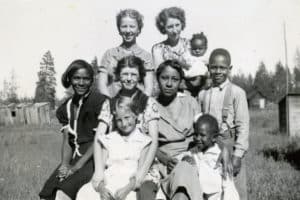
This contemporary absence is the result of centuries-old discrimination that prevented Blacks from settling in the region during the nineteenth century. The provisional and territorial governments of Oregon passed three exclusion laws that explicitly forbid African Americans from coming to or residing in Oregon. Still, a handful of African Americans—both free and enslaved—began arriving in Oregon with overland wagon trains between 1840 and 1870. Almost all of them settled in the Willamette Valley, but around the turn of the century a small number of enterprising Blacks began to make their way to Eastern Oregon, seeking new opportunities as ranchers, miners, loggers, and farmers.
Examples reflect a wide geographic range of Black settlement in Oregon that is hard to imagine today. Black fur traders and explorers like Moses Harris and James Beckwourth traversed the far eastern corners of the Oregon Territory in the 1820s and 1830s. After the Oregon Trail was established, individual settlers began staking claims in eastern Oregon. John Brown came from Canada to settle in what is today the Warm Springs Reservation, and former-slave-turned-business-owner William Livingstone left behind 180 acres in eastern Lake County after his death. Others came seeking gold. A discovery in Canyon Creek in the 1890s brought thousands of fortune seekers to the John Day area, including Columbus Sewell and his wife, Louisa, who later operated a Canyon City freight company. A few decades later, the Bowman-Hicks Lumber Company recruited Black loggers from eastern states to work alongside its white employees in the town of Maxville. The mixed-race community was the largest town in Wallowa County from 1924-1933.

Today it is hard to find evidence of those trailblazing Black settlers. Oregon Black Pioneers (OBP), Oregon’s only statewide African American historical society, is working to change that. The Salem-based nonprofit works to illuminate the seldom-told stories of the state’s first Black residents through exhibitions, public programs, monuments, and more. OBP’s volunteer researchers use newspapers, family histories, and census records to give life to Black individuals and communities that have been left out of larger narratives of Oregon’s heritage. In 2020, an effort to commemorate the experiences of an eastern Oregon ranching family began with a Facebook post.
In June, the Western History Room at Harney County Library posted a story about the Andersons on its Facebook page. At some point in the 1910s, brothers Oscar and Walter Anderson moved together to Harney County to take up ranching. Oscar established his homestead on Trout Creek, just north of Burns. Walter established a ranch of his own at Juniper Lake, some 90 miles farther south in the eastern shadow of Steens Mountain. About 15 years later, Walter married a woman named Martha, who joined him on the ranch. The couple spent another 25 years there before Walter’s poor health forced them to move to Portland in 1952. For 40 years, the Andersons may have been the only Black residents of Harney County. Walter died in 1958, and afterward Martha published the book Black Pioneers of the Northwest, 1800-1918. The library’s post mentioned that the couple is buried in unmarked graves in the Burns Pioneer Cemetery.

Members of the group Rural Alliance for Diversity (RAD) in Burns saw the library’s post. RAD is a group dedicated to fighting white supremacy and creating inclusive spaces for BIPOC, LGBTQ+, disabled folks, and all other marginalized groups living in and visiting Harney County. RAD contacted Oregon Black Pioneers to see if OBP could support them in a project to raise awareness and funds for the creation of a grave marker for the Andersons. OBP was familiar with the Andersons from Martha’s book, and from a 1970 letter in its files from the administrator of the Malheur National Wildlife Refuge, who wrote of the Andersons, “They were well-respected, nice people and it didn’t seem to occur to anyone that they were Black. They attended public dances, rodeos, and other public entertainment, just the same as did the white people.” OBP used its website and newsletter to highlight the grave marker campaign and successfully raised funds from Roundhouse Foundation in Sisters to complete the project. In 2021, a permanent headstone for Martha and Walter Anderson will finally be erected, and OBP will present a guest lecture to RAD members about the history of Blacks in Eastern Oregon.
New stories of Eastern Oregon’s Black pioneers are being rediscovered every day. This work is possible thanks to leads and efforts from locals who believe Oregon’s diverse history should be celebrated and explored, even in the most remote corners. As part of their work in Eastern Oregon, Bird Alliance of Oregon works with RAD on projects like the Anderson Memorial Project and by providing outdoor recreational and stewardship opportunities for community members and marginalized individuals from around the state.


Blacks on the Frontier - Feb. 23 @ 5:30 - 7:30 p.m.
Early Blacks in rural Oregon represented the most marginalized members of an already vulnerable racial minority. This talk will highlight the unique experiences of some of the few Blacks who, in the absence of larger communities of support, settled on Oregon’s frontier, and the lessons that can be learned from their example.
Learn More


